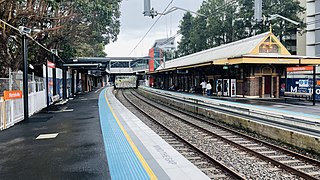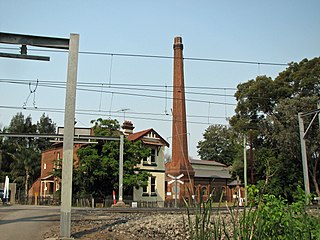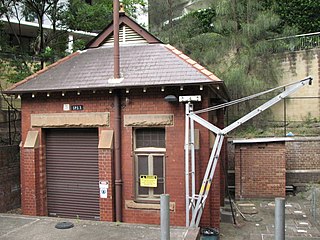
Marrickville is a suburb in the Inner West of Sydney, in the state of New South Wales, Australia. Marrickville is located 7 kilometres south-west of the Sydney central business district and is the largest suburb in the Inner West Council local government area.

Sydenham railway station is a heritage-listed railway station located on the Illawarra line, serving the Sydney suburb of Sydenham in New South Wales, Australia. It is served by Sydney Trains' T4 Illawarra & Eastern Suburbs Line and T8 Airport & South Line services, and Sydney Metro's North West & Bankstown Line services. It was designed by New South Wales Government Railways and opened in 1884, with William Robinson having built the original station buildings. It was added to the New South Wales State Heritage Register on 2 April 1999.

The Tank Stream is a heritage-listed former fresh water tributary of Sydney Cove and now tunnel and watercourse located in the Sydney central business district, in the City of Sydney local government area of New South Wales, Australia. The Tank Stream was the fresh water supply for the fledgling colony of New South Wales in the late 18th century. Today it is little more than a storm water drain. It originated from a swamp to the west of present-day Hyde Park and at high tide entered Sydney Cove at what is now the intersection of Bridge and Pitt Streets in the Sydney central business district. The catchment was 65 hectares, corresponding roughly the size of the Sydney central business district. It was added to the New South Wales State Heritage Register on 2 April 1999.

Tempe is a suburb in the Inner West of Sydney, in the state of New South Wales, Australia. Tempe is located 9 kilometres south of the Sydney central business district in the local government area of Inner West Council.

Marrickville railway station is a heritage-listed railway station located on the Bankstown railway line, serving the Sydney suburb of Marrickville. It was added to the New South Wales State Heritage Register on 2 April 1999.

Sydenham is a suburb in the Inner West of Sydney, in the state of New South Wales, Australia. Sydenham is located 8 kilometres south of Sydney central business district and is part of the local government area of Inner West Council. Sydenham is surrounded by the suburbs of Marrickville, St Peters and Tempe.

The Woronora Dam is a heritage-listed concrete gravity dam with an uncontrolled serpentine spillway across the Woronora River, located south of Greater Metropolitan Sydney, in the suburb of Woronora Dam, Sutherland Shire, New South Wales, Australia. The principal purpose of the dam is for potable water supply for Sydney's southern suburbs and the northern suburbs of the Illawarra region. The impounded 71,790-megalitre reservoir is also called Woronora Dam and is sometimes incorrectly called Lake Woronora. The dam was designed by G. E. Haskins, Chief Engineer and the Metropolitan Water, Sewerage and Drainage Board of NSW (MWS&DB) and built from 1927 to 1941 by the MWS&DB. The property is owned by the Sydney Catchment Authority, an agency of the Government of New South Wales. It was added to the New South Wales State Heritage Register on 18 November 1999.

The Alexandra Canal, a tributary of the Cooks River, is a heritage-listed artificial waterway in southern Sydney, New South Wales, Australia. Alexandra Canal was named after Princess Alexandra, who married Edward, Prince of Wales in 1863.
Coxs Creek, a watercourse of the Cooks River catchment, is located in the Inner West of Sydney, in New South Wales, Australia.

Walka Water Works is a heritage-listed 19th-century pumping station at 55 Scobies Lane, Oakhampton Heights, City of Maitland, New South Wales, Australia. Originally built in 1887 to supply water to Newcastle and the lower Hunter Valley, it has since been restored and preserved and is part of Maitland City Council's Walka Recreation and Wildlife Reserve. It was added to the New South Wales State Heritage Register on 2 April 1999.

The Manly Dam is a heritage-listed dam near King Street, Manly Vale with a reservoir extending into Allambie Heights, both in the Northern Beaches Council local government area of New South Wales, Australia. It is often used as a place to have recreational activities. The reservoir is located within the Manly Dam Reserve. The dam was designed by the NSW Department of Public Works and built in 1892 by the Department. The reservoir and dam is owned by Sydney Water, an agency of the Government of New South Wales. The reservoir and dam was added to the New South Wales State Heritage Register on 18 November 1999.

The Tenterfield railway station is a heritage-listed closed railway station and now railway museum located on the Main Northern line, Tenterfield, Tenterfield Shire, New South Wales, Australia. It served the town of Tenterfield and opened on 1 September 1886 when the line was extended from Glen Innes. It was the terminus of the line until it was extended to Wallangarra on 16 January 1888. The railway station was designed by William Murray under the direction of John Whitton, the Chief Engineer of NSW Government Railways, and built during 1886. It is also known as Tenterfield Railway Station group. The property was added to the New South Wales State Heritage Register on 2 April 1999. The station has one platform with two loops.

Lewisham Sewage Aqueduct is a heritage-listed sewage aqueduct in Gadigal Reserve, adjacent to 5 Grosvenor Crescent, Summer Hill, Inner West Council, Sydney, New South Wales, Australia. It was designed by Sewerage Construction Branch and Department of Public Works and built in 1900. The property is owned by Sydney Water. It was added to the New South Wales State Heritage Register on 18 November 1999.

The Ryde Pumping Station is a heritage-listed pumping station and offices located at Victoria Road, West Ryde, New South Wales, Australia. It was built from 1891 to 1921 by William Adams & Co. Ltd., State Monier Works, Refshaw & O'Brien. It is also known as Ryde Pumping Station and site, WP005 and West Ryde Pumping Station. The property is owned by Sydney Water. It was added to the New South Wales State Heritage Register on 15 November 2002.

Sewage Pumping Station 271 is a heritage-listed sewage pumping station located adjacent to 5 Carrington Road, Marrickville, Inner West Council, Sydney, New South Wales, Australia. It was designed and built by the New South Wales Public Works Department. It is also known as SPS 271. The property is owned by Sydney Water. It was added to the New South Wales State Heritage Register on 18 November 1999.

The Ultimo Sewage Pumping Station is a heritage-listed sewerage pumping station located at William Henry Street in the inner city Sydney suburb of Ultimo in the City of Sydney local government area of New South Wales, Australia. As a result of the construction of an elevated roadway along William Henry Street, the pumping station now fronts Pyrmont Street, with vehicles being required to enter via Quarry Street, then turning right into Pyrmont Street.

The Rushcutters Bay Sewage Pumping Station is a heritage-listed sewerage pumping station located at Rushcutters Bay Park in the inner city Sydney suburb of Rushcutters Bay in the City of Sydney local government area of New South Wales, Australia. It was designed and built by the New South Wales Public Works Department from 1902 to 1904. It is also known as Sewage Pumping Station 18 and SPS 18. The property is owned by Sydney Water. It was added to the New South Wales State Heritage Register on 18 November 1999.

The Hydraulic Pump Station is a heritage-listed former hydraulic power station and now bar at 17 Little Pier Street, Haymarket, City of Sydney, New South Wales, Australia. It was built from 1889 to 1891. It was added to the New South Wales State Heritage Register on 2 April 1999.

Sewage Pumping Station 3 is a heritage-listed sewerage pumping station located near 1 Booth Street, Annandale, City of Sydney, New South Wales, Australia. The building is located adjacent to Johnstons Creek. It was built from 1902 to 1904 by the New South Wales Public Works Department. It is also known as SPS 3, SP0003, Booth Street Sewage Pumping Station and Annandale Sewage Pumping Station. The property is owned by Sydney Water. It was added to the New South Wales State Heritage Register on 18 November 1999.
Cootamundra World War II Fuel Depot is a heritage-listed former fuel depot and Royal Australian Air Force (RAAF) stores depot and now public park at 219 Sutton Street, Cootamundra, New South Wales, Australia. It was built from 1941 to 1943. It is also known as Cootamundra World War II Fuel Depot Site, Inland Aircraft Fuel Depot No.3, IAFD No.3, former World War II RAAF base, Petrol tanks and Ampol service station. The property is owned by Ampol and the Cootamundra–Gundagai Regional Council, a local government authority. The depot was added to the New South Wales State Heritage Register on 27 February 2015.




















